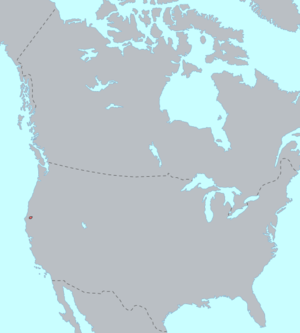- Chimariko language
-
Chimariko Spoken in USA Region California Extinct ca. 1910 Language family Hokan?- Chimariko
Language codes ISO 639-3 cid  Pre-contact distribution of Chimariko
Pre-contact distribution of ChimarikoThis page contains IPA phonetic symbols in Unicode. Without proper rendering support, you may see question marks, boxes, or other symbols instead of Unicode characters. Chimariko is an extinct language isolate formerly spoken in Trinity County in northwestern California by Chimariko peoples.
Contents
Genetic relations
Proposals linking Chimariko to other languages in various versions of the hypothetical Hokan family have been advanced. Roland Dixon suggested a relationship between Chimariko and the Shastan and Palaihnihan families. Edward Sapir's famous 1929 classification grouped Chimariko with Shastan, Palaihnihan, Pomoan, and the Karuk and Yana languages in a Hokan sub-grouping known as Northern Hokan. A Kahi family consisting of Chimariko, Shastan, Palaihnihan, and Karuk has been suggested (appearing also within Sapir's 1929 Northern Hokan). Most specialists currently find these relationships to be undemonstrated, and consider Chimariko to remain best considered an isolate.[citation needed]
Documentary History
Roland Dixon began work on the Chimariko language in the early 1900s, when there were few remaining speakers. Dixon worked with two: Mrs. Dyer and a man who was named Friday.[1] Later, extensive documentation on the language was carried out by J.P. Harrington, who worked with Sally Noble, the last speaker of the language.[2] Harrington's assistant John Paul Marr also made recordings of the language with speaker Martha Zigler.[3]
Phonology
Consonantal inventary of chimariko is:[4]
Labial Dental Post-
alveolarPalatal Velar Uvular Glottal Plosive plain p t ṭ k q aspirated pʰ tʰ ṭʰ kʰ qʰ glottalized p’ t’ ṭ’ k’ q’ ʔ Affricate simple c č aspirated cʰ čʰ glottalized c’ č’ Fricative s š x χ h Sonorant nasal m n non-nasal l, r y w Grammatical characteristics
Because the documentary corpus of Chimariko was limited, the description of the grammar of the language was not complete.[1] However, general observations were made.
Among the recorded grammatical characteristics are the following: Chimariko had reduplication in many nominal forms, particularly in the names of fauna (e.g., tsokoko-tci "bluejay", himimitcei "grouse"). Like many American languages (such as Shasta, Maidu, Wintun, as well as Shoshonean, Siouan, and Pomo), Chimariko verbs had a series of instrumental and body-part prefixes, indicating the particular body part or object with which an action was carried out.[1]
References
- ^ a b c Sapir, Edward (1911 [1990]). "Review of Roland B. Dixon: The Chimariko Indians and Language". New York: Mouton de Gruyter. pp. 185–187. ISBN 0899256546.
- ^ Luthin, Herbert (2002). Surviving through the Days. Berkeley: University of California Press. ISBN 9780520222700.
- ^ "Chimariko Sound recording n.d". collections.si.edu. http://collections.si.edu/search/results.jsp?view=&date.slider=&fq=online_media_type%3A%22Sound+recordings%22&fq=online_visual_material%3Atrue&q=Harrington%2C&dsort=&fq=language:%22Chimariko%22. Retrieved 9 May 2010.
- ^ Carmen Jany, 2007, p. 112
External links
- Fieldnotes on Chimariko by Alfred Kroeber at the Bancroft Library at UC Berkeley
- Chimariko language overview at the Survey of California and Other Indian Languages
Bibliography
- Campbell, Lyle. (1997). American Indian languages: The historical linguistics of Native America. New York: Oxford University Press. ISBN 0-19-509427-1.
- Goddard, Ives (Ed.). (1996). Languages. Handbook of North American Indians (W. C. Sturtevant, General Ed.) (Vol. 17). Washington, D. C.: Smithsonian Institution. ISBN 0-16-048774-9.
- Mithun, Marianne. (1999). The languages of Native North America. Cambridge: Cambridge University Press. ISBN 0-521-23228-7 (hbk); ISBN 0-521-29875-X.
- Carmen Jany (2007): "Is there any evidence for complementation in Chimariko?", International Journal of American Linguistics, Volume 73, Issue 1, pp. 94–113, Jan 2007.
Categories:- Languages of the United States
- Language isolates of North America
- Indigenous languages of California
- Extinct languages of North America
- Hokan languages
- Indigenous languages of the Americas stubs
Wikimedia Foundation. 2010.
